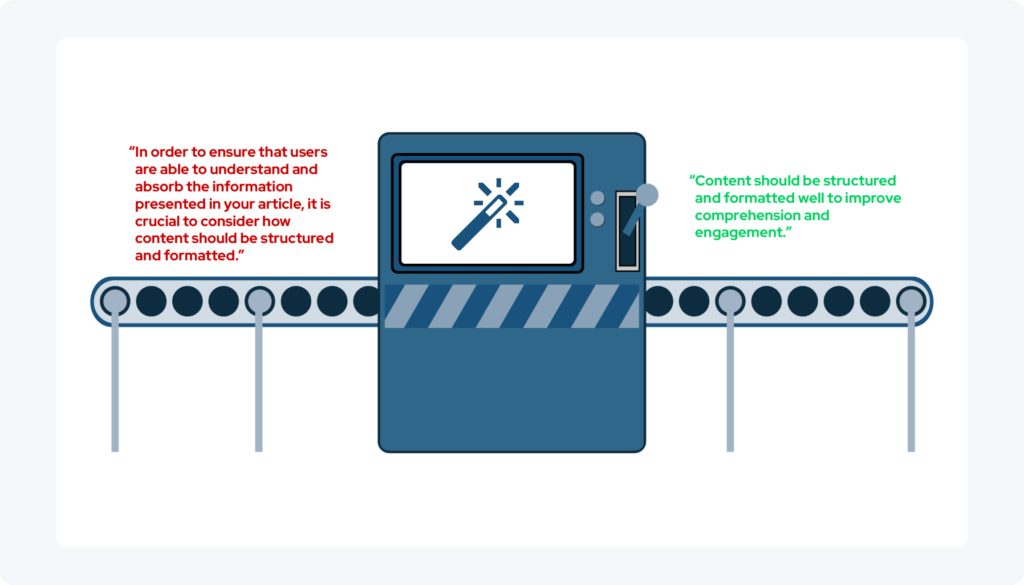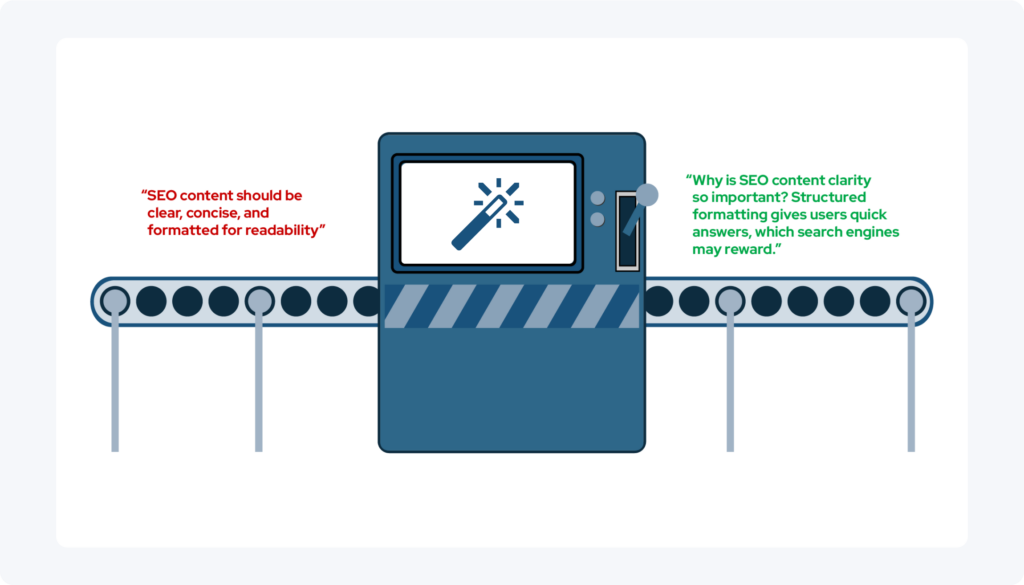Executive Summary
- Ensuring your brand’s digital content is easily readable can improve user engagement, information retention, and SEO rankings.
- Prioritizing short sentences, questions with direct answers, and varied formatting can improve reading comprehension and accessibility for people with unique learning styles.
- Try breaking up blurbs of content with bulleted lists, graphics, and CTAs to make the blog, service page, or whitepaper more digestible.
- Relying on professional SEO content writing services can guarantee your target audience responds well to your brand’s content, to more easily connect with your organization.
Learning How to Write Digestible Content for SEO Value
In today’s content-saturated digital climate, the readability of a blog, service page, or whitepaper can significantly impact the success of a brand’s online marketing strategies. It’s not just about terminology and tone; content format substantially influences how comprehensible writing is and how likely a reader is to engage with it.
In SEO content writing, brands should use short, direct sentences, simple question-answer layouts, and visual elements to make digital pieces more digestible and better ranked by search engines like Google. Writers should also ensure every sentence has meaning and is tailored to the target audience’s knowledge and potential learning styles.
If you want to find out how to make your writing more engaging and increase your brand’s impact, read through the seven practices below—this guide features content writing tips for beginners and seasoned professionals alike to ensure your company’s digital content is as coherent, engaging, and high-ranking as possible.
Why Is Digestible Content Important?
Writing a well-organized article can simultaneously improve SEO rankings and enhance the user experience. SEO writing isn’t just about keyword research and inclusion; most search engines favor structured, easy-to-read content, meaning well-formatted written content will often be boosted in the search results of websites like Google.
Once people find your strategically organized blog, service page, or whitepaper thanks to its boosted SEO potential, the clear writing can also hold readers for longer and lead to higher information retention rates. Plus, that extended engagement will only reinforce your SEO ranking potential even further, demonstrating your content’s value to search engines.
Making certain formatting choices can allow you to cater to diverse learning styles and attention spans, which are steadily decreasing when it comes to digital media consumption. Research shows that back in 2004, the average attention span for a person on any screen was roughly two and a half minutes long; however, between 2017 and 2023, that average had dropped significantly to about 47 seconds.
With such short windows to capture a reader’s attention, every brand needs to ensure they are putting out digestible content to keep readers engaged.
SEO Content Writing Tips for Readability and Engagement
The seven techniques below can help organizations format content for a PDF or webpage to appeal to search engine preferences while enhancing clarity and engagement among their readers.
1. Incorporate Short, Snappy Sentences
Breaking up statements into shorter, bite-sized sentences can reduce a reader’s cognitive load, ultimately preserving their attention and improving comprehension. An in-depth study revealed that sentence length significantly affects readability. Most people exhibit the highest comprehension and lowest workload when reading sentences with between 16 and 20 words.
Some practices you can implement to build writing habits that yield short, snappy sentences include:
- Focusing on one idea per sentence
- Removing redundant words and excessive clauses
- Using active voice for clarity

2. Deliver Clear and Immediate Answers to Questions
Both users and algorithm-operated search engines prefer quick, direct answers to queries. By satisfying this desire, your company can improve dwell time and click-through rates (CTRs).
Be concise and considerate of the reader’s time by writing H2 and H3 headings as SEO-friendly questions, then answering those queries directly in the opening sentence of that section. You might also consider including a frequently asked questions (FAQ) section at the end of the webpage to help people find exactly what they’re looking for.
Research from Nielsen Norman Group found that 79% of users scanned new pages they came across, while only 16% read word-by-word. Using text formatting styles to make answers to questions look more apparent can help writers capture the attention of skimming readers. Relying on visual tools like bolded or highlighted text is a great way to quickly satisfy someone’s search intent.
3. Diversify Text with Graphics, CTAs, or Bulleted Lists
Research finds that 65% of people are visual learners, meaning breaking up dense paragraphs with charts, infographics, and tables can improve retention and enhance readability for many.

A reliable, experienced content writing agency like collystring can ensure CTAs and other diverse writing tools are smoothly incorporated into your organization’s online content.
4. Rely on Short Paragraphs
Since large text blocks overwhelm readers, it’s imperative to rely on shorter paragraphs. Strictly sectioning off ideas into their own miniature paragraph can help you create more white space on the page, which can improve scannability and engagement.
Although some topics may warrant exceptions, as a general rule of thumb, you should try to keep paragraphs between 2 and 3 sentences long, depending on the sentence length. You can keep your piece organized even further by using subheadings to separate larger concepts. In turn, this can elevate SEO and enhance domain authority.
5. Ensure Every Sentence Has Meaning
Using filler words and being redundant can decrease engagement—every word should serve a purpose. It can be challenging to identify unnecessary words without hearing them, so you should read content aloud during your editing process.
Some common mistakes to look out for during review are:
- Overusing adverbs of degree, like “very,” “extremely,” or “almost”
- Using redundant phrases, such as “absolutely essential”
- Opting for passive voice when active voice is more straightforward
When going through your work, edit as ruthlessly as possible to guarantee every sentence adds value and avoids cognitive overload.

6. Vary Your Sentence Structure
Although you should incorporate short sentence structures and visual elements like lists, switching things up is vital because using repetitive techniques can make writing monotonous. Implement a mix of short, medium, and long sentences to create a natural flow.
You can improve the variety within your website content writing by mixing declarative and interrogative sentences. After integrating multiple sentence structures, you should have a third party read the content aloud. This process can make it easier for you to check the writing’s natural rhythm.

7. Know Your Audience
Different industries require tailored formatting and tone, so understanding who you are writing for is one of the best practices for SEO content writing. For instance, lawyers may be able to digest long, detailed explanations of complex legal topics, while a general audience may benefit from shorter writing with conversational language.
Some tips to help you understand your audience include:
- Review competitor content from those in the same market
- Research what information is most important to your audience
- Consider the tone of your audience and whether it’s more casual or academic
Many writers end up using clear headings and bullet points with in-depth explanations for technical audiences, a conversational tone with visuals for casual readers, and scannable content with optional deep dives for professionals.
When in doubt, you should use plain language to increase the overall accessibility of your piece. You should also ensure your different writing formats are optimized for mobile and desktop users by reviewing your work on both platforms.
Get Easily Consumable SEO Content from the Experts at collystring
Implementing the seven SEO content writing tips mentioned above can drastically enhance readability and search rankings through your content format choices, such as using short paragraphs, including visuals, and ensuring every sentence adds value. However, employing professional content writing services from a dependable team is the best way to guarantee your written content is as digestible and effective as possible.
If you’re looking to increase engagement rates in your SEO content writing, turn to the team at collystring. Our people-forward agency can write a wide variety of digital content on your brand’s behalf, including quick topic-focused blog posts, sales-forward service pages, and long, informative whitepapers. Plus, as a comprehensive digital marketing agency prepared to implement a well-rounded strategy, ranging from Paid Social to Data and Analytics, collystring will be the last agency you will ever need.
Contact us today to enhance your digital marketing strategy with expertly formatted, high-impact content.


